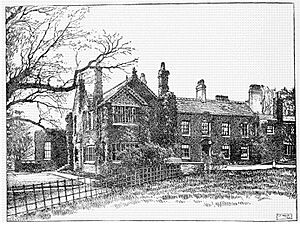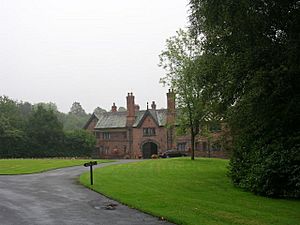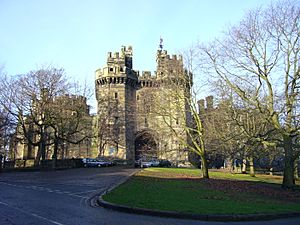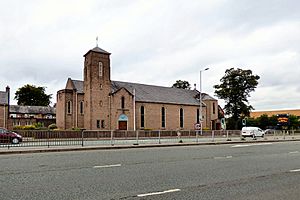Ambrose Barlow facts for kids
Quick facts for kids SaintAmbrose Edward Barlow OSB |
|
|---|---|
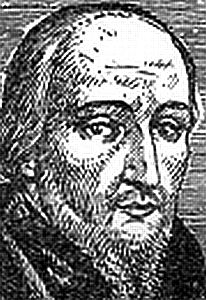 |
|
| Benedictine monk and martyr | |
| Born | c. 1585 Barlow Hall, Chorlton-cum-Hardy, Manchester, Lancashire, England |
| Died | 10 September 1641 (aged 55 - 56) Lancaster, Lancashire, England |
| Venerated in | Roman Catholic Church |
| Beatified | 15 December 1929, St. Peter's Basilica, Vatican City by Pope Pius XI |
| Canonized | 25 October 1970, St. Peter's Basilica, Vatican City by Pope Paul VI |
| Feast | 10 September (individual) 7 August (one of the Lancaster Martyrs)< 25 October (together with Forty Martyrs of England and Wales) 29 October (one of the Douai Martyrs) |
| Attributes | Martyr's palm, bible, crucifix, noose in neck, rosary |
| Patronage | Manchester, people with stroke |
Ambrose Edward Barlow, also known as Edward Barlow, was an English Benedictine monk. He lived from 1585 to 1641. He is honored as a saint in the Catholic Church. He is one of the Forty Martyrs of England and Wales, a group of saints recognized by Pope Paul VI.
Contents
Early Life and Faith Journey
Ambrose was born in 1585 at Barlow Hall, near Manchester, England. He was the fourth son of Sir Alexander Barlow, a nobleman, and Mary Brereton. His family, the Barlows, had been forced to join the Church of England. This happened after the Catholic Church was banned in England.
Ambrose's grandfather was even put in prison for his Catholic beliefs. His father lost much of his land because he refused to follow the new rules. Ambrose was baptized as "Edwarde" on November 30, 1585.
At age twelve, Edward became a page for a Protestant cousin. He followed the Anglican faith until 1607. Then, a friend helped him return to Roman Catholicism.
Becoming a Priest
After his apprenticeship, Ambrose felt called to become a priest. He traveled to Douai in France to study at the English College. He also studied in Valladolid, Spain.
In 1613, while visiting England, he was jailed for his Catholic beliefs. After being released, he went back to Douai in 1615. There, he joined the English Benedictine monks at St. Gregory's. His brother, Dom Rudesind Barlow, was the leader there. Ambrose joined the Order of Saint Benedict and took the name Ambrose. He was ordained as a priest in 1617.
Secret Mission in England
After becoming a priest, Ambrose returned to England in 1617. Being a Catholic priest in England was against the law and very dangerous. It was considered treason.
He first went to Barlow Hall. Then, he moved to Morleys Hall in Astley, the home of Sir Thomas Tyldesley. For 24 years, he worked secretly in south Lancashire. This area was somewhat safer for Catholics. Sir Thomas's grandmother provided money to help him serve the poor Catholics in his area.
Serving His Community
Ambrose secretly held daily Mass and prayed for his Catholic "parishioners." He was known for his kindness and humor. He was much loved by the poor people he served. He would also invite them to his house for special feasts.
To avoid being caught, he had a special routine. He would travel around the parish for four weeks. Then, he would stay hidden at the Hall for five weeks. He often visited his cousins, the Downes, at Wardley Hall. There, he would hold Mass for the people who gathered.
Arrest and Martyrdom
Ambrose was arrested four times during his travels. Each time, he was released without charges. However, King Charles I made a new rule on March 7, 1641. It said all priests must leave England within a month or be arrested and treated as traitors.
Ambrose's parishioners begged him to leave or hide. He refused, saying, "Let them fear that have anything to lose which they are unwilling to part with." Their worries grew because Ambrose, at 56, had recently had a stroke and was partly paralyzed.
Final Capture and Trial
On Easter Day, April 25, 1641, Ambrose and about 150 people were at Mass at Morleys Hall, Astley. They were surrounded by the Vicar of Leigh and about 400 armed people. Father Ambrose gave himself up. His parishioners were released after their names were written down.
The priest was tied up and taken on a horse to the Justice of the Peace at Winwick. Then, he was taken to Lancaster Castle. It is said that he had a dream that Edmund Arrowsmith appeared to him. In the dream, Arrowsmith told him he would also become a martyr.
Father Ambrose appeared before Judge Sir Robert Heath on September 7. He bravely stated his Catholic faith and defended his actions. On September 8, the judge found him guilty. Ambrose was sentenced to death.
Execution
Two days later, on September 10, Ambrose was taken from Lancaster Castle. He was pulled on a wooden frame to the execution site. He was put to death in a very harsh way, as was common for traitors at that time. His head was then displayed on a pole.
His cousin, Francis Downes, who was a devout Catholic, saved Ambrose's skull. He kept it at Wardley Hall, where it remains today. When news of his death reached his Benedictine brothers in Douai, they celebrated with a special Mass.
Becoming a Saint
On December 15, 1929, Pope Pius XI declared Father Ambrose "Blessed." This happened at a special ceremony in St. Peter's Basilica, Vatican City.
Later, on October 25, 1970, Pope Paul VI officially made him a saint. This was part of a group of many British Catholic martyrs. They are known as the Forty Martyrs of England and Wales.
Relics and Legacy
Many items connected to Saint Ambrose are still preserved today. These are called relics.
- His jaw bone is kept at the Church of St Ambrose of Milan in Barlow Moor, Manchester.
- His left hand is at Stanbrook Abbey in North Yorkshire.
- His right hand is at Mount Angel Abbey in St. Benedict, Oregon, USA.
- His skull is kept at Wardley Hall in Worsley. This was once the home of the Downes family. It is now the home of the Catholic Bishop of Salford.
Remembering Saint Ambrose
Several places are named after Saint Ambrose Barlow.
- The Church of St Ambrose of Milan at Barlow Moor was founded in 1932. It was originally named after Ambrose of Milan. But it was changed to St Ambrose Barlow after he became a saint.
- The St Ambrose Barlow Roman Catholic church and primary school in Astley are also named after him.
- Other schools include The Barlow Roman Catholic High School in Didsbury, St Ambrose Barlow Roman Catholic High School in Swinton, and St Ambrose Barlow Catholic High School in Netherton, Merseyside.
- One of the boarding houses at Downside School is named Barlow in his honor.
An association of Benedictines, called the Oblate Chapter of Douai Abbey, has Saint Ambrose Barlow as its patron saint.
Images for kids
-
The blue plaque outside Manchester Cathedral


